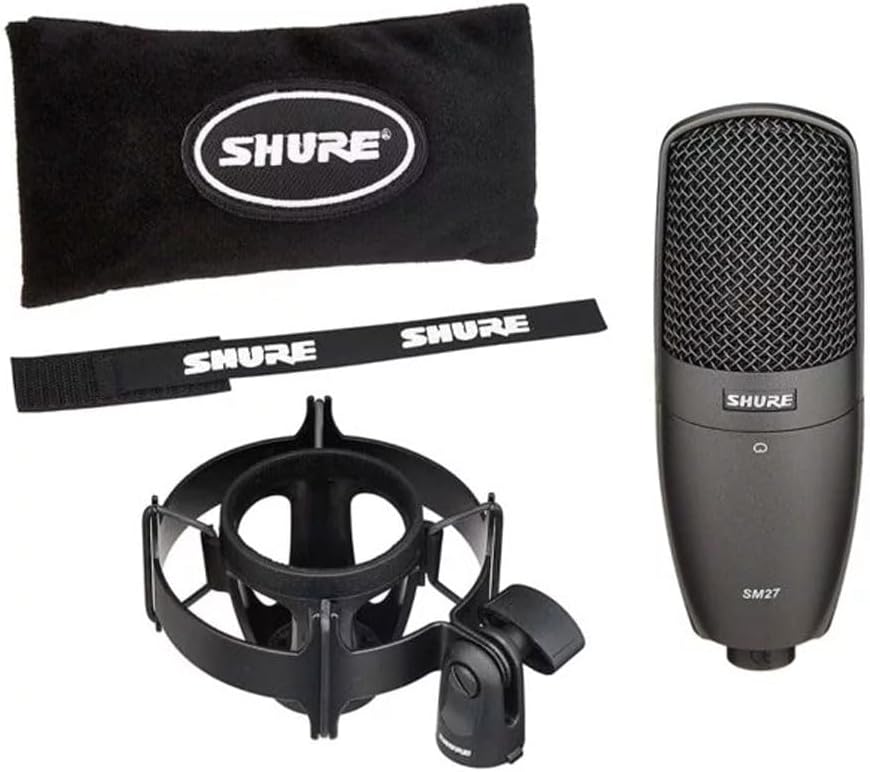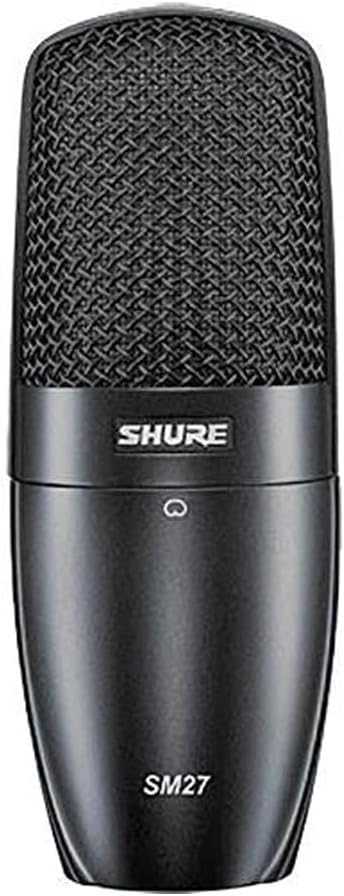Shure SM27 Review
When it comes to microphones, Shure is a name that commands respect. Known for decades of reliability and innovation, Shure has built a reputation for crafting audio tools that cater to everyone from bedroom producers to world-class recording engineers. The Shure SM27, a large-diaphragm condenser microphone, sits comfortably in their lineup as a versatile, professional-grade option that promises to deliver exceptional sound quality at a reasonable price point. In this review, we’ll explore every facet of the SM27—its build, features, sound profile, practical applications, and how it stacks up against competitors—to determine whether it’s worth your investment.
Shure SM27 Review
The Shure SM27 is marketed as a multi-purpose microphone, designed for both studio recording and live sound reinforcement. It’s a cardioid condenser mic, meaning it captures sound primarily from the front while rejecting noise from the sides and rear. With a frequency response of 20 Hz to 20 kHz, a switchable low-cut filter, and a -15 dB pad, it’s built to handle a wide range of sources—from delicate vocals to loud guitar cabinets. At first glance, the SM27 exudes the kind of understated professionalism Shure is known for: it’s not flashy, but it feels purposeful.
Unboxing the SM27 reveals a sturdy microphone, a shock mount, and a padded carrying pouch. The mic weighs in at 1.41 lbs (642 grams), giving it a solid, reassuring heft without being unwieldy. Its matte black finish and sleek design make it visually appealing, though it’s clear this is a tool meant for work, not show. Compared to its more famous sibling, the Shure SM7B, the SM27 feels less iconic but more modern, with a focus on versatility rather than a singular vocal-forward purpose.
Build Quality and Design
Shure microphones are synonymous with durability, and the SM27 is no exception. The body is constructed from die-cast metal, giving it a ruggedness that suggests it can withstand the rigors of both studio and stage use. The grille, which protects the 1-inch diaphragm, is made of steel mesh and feels robust enough to handle accidental bumps or drops. This is a microphone built to last, and Shure backs that up with a reputation for gear that endures years of heavy use.
The SM27 features a large, gold-layered Mylar diaphragm, which contributes to its sensitivity and clarity. The mic requires 48V phantom power, standard for most condensers, and connects via a 3-pin XLR output. On the body, you’ll find two switches: one for a -15 dB pad and another for a low-cut filter at 115 Hz or 80 Hz (depending on the setting). These controls are simple but effective, offering flexibility without overwhelming the user with options.
The included shock mount is a standout accessory. It’s a high-quality, elastic-suspension design that effectively isolates the mic from vibrations and handling noise. Whether you’re recording in a treated studio or a less-than-ideal space, the shock mount ensures cleaner takes by minimizing unwanted rumble. The carrying pouch, while not as luxurious as a hard case, is practical for transport and storage.
Sound Quality: The Heart of the SM27
A microphone’s sound is its defining trait, and the SM27 delivers a balanced, natural profile that suits a variety of applications. Its cardioid polar pattern provides excellent off-axis rejection, making it ideal for recording in environments where isolation is key. The frequency response is flat and transparent across the midrange, with a subtle presence boost around 5-10 kHz that adds air and detail without sounding harsh. The low end is full but controlled, thanks in part to the switchable low-cut filter, which tames excessive bass when needed.
Vocals: When used on vocals, the SM27 shines with its ability to capture nuance. It’s not as warm or colored as a tube condenser like the AKG C414, but its neutrality makes it a blank canvas for engineers who prefer to shape the sound in post-production. The mic handles sibilance well, and its high SPL (sound pressure level) handling—up to 138 dB with the pad engaged—means it can take powerful singers without distortion. Compared to the Shure SM7B, the SM27 is brighter and more open, lacking the SM7B’s signature midrange thickness but offering greater detail in the highs.
Instruments: The SM27 excels on acoustic instruments. On acoustic guitar, it captures the shimmer of the strings and the body’s resonance with clarity and depth. The low-cut filter is handy here, allowing you to roll off unwanted low-end rumble from room noise or finger movement. For drum overheads, the SM27 performs admirably, picking up cymbal detail and transients while maintaining a cohesive image of the kit. It’s not as surgical as a small-diaphragm condenser like the Neumann KM 184, but its larger diaphragm gives it a slightly warmer, more rounded tone.
Loud Sources: With the -15 dB pad engaged, the SM27 can handle high-SPL sources like electric guitar amps and brass instruments. In a live setting, this makes it a viable option for miking cabinets or horns, though its condenser nature means it’s less forgiving of feedback than a dynamic mic like the Shure SM57. Still, the pad and cardioid pattern keep it manageable in controlled environments.
The SM27’s self-noise is impressively low at 9.5 dB (A-weighted), ensuring clean recordings even with quiet sources. This is a significant advantage over budget condensers, where hiss can become an issue. Overall, the sound is professional and polished—nothing revolutionary, but consistently reliable across applications.
Features and Flexibility
The SM27’s feature set is straightforward but thoughtfully implemented. The -15 dB pad is a lifesaver for loud sources, effectively expanding the mic’s dynamic range. The low-cut filter, with options at 115 Hz (6 dB/octave) or 80 Hz (18 dB/octave), provides practical control over proximity effect and room noise. These aren’t groundbreaking additions, but they’re executed with precision, making the SM27 adaptable to diverse recording scenarios.
The cardioid pattern is fixed, which might disappoint users looking for the multi-pattern versatility of mics like the Rode NT2-A or Audio-Technica AT4050. However, for most studio and live tasks, cardioid is the go-to choice, and the SM27’s tight pickup pattern ensures focus on the source. The lack of additional polar patterns keeps the mic’s design simple and its price competitive.
Practical Applications
The SM27’s versatility makes it a strong contender for both home studios and professional setups. In a recording studio, it’s an excellent all-rounder for vocals, acoustic guitars, pianos, and drum overheads. Its clarity and low noise floor make it suitable for podcasting or voiceover work, though it lacks the SM7B’s built-in pop filter and iconic broadcast tone. For live sound, the SM27 can handle reinforcement duties on quieter stages or in controlled settings, but it’s not as rugged or feedback-resistant as a dynamic mic.
Home studio owners will appreciate the SM27’s plug-and-play simplicity. Pair it with a decent audio interface and preamp, and you’ve got a setup capable of pro-level results. For engineers with more demanding needs, it’s a solid utility mic that complements specialized options without breaking the bank.
Comparisons to Competitors
To understand the SM27’s value, let’s compare it to a few peers in its price range (typically $300-$400 USD).
- Shure SM7B ($399): The SM7B is a dynamic mic with a darker, thicker sound, beloved for vocals and broadcasting. The SM27, being a condenser, offers more detail and openness but lacks the SM7B’s warmth and built-in windscreen. The SM7B is better for untreated rooms; the SM27 suits cleaner spaces.
- Audio-Technica AT4040 ($299): The AT4040 is another cardioid condenser with a bright, detailed sound. It’s slightly cheaper and has a more pronounced high-end boost, which some find flattering on vocals. The SM27 feels sturdier and has a flatter response, appealing to those who prioritize neutrality.
- AKG C214 ($479): The C214, a single-pattern sibling to the C414, offers a richer, more polished sound with a higher price tag. It’s more refined on vocals and instruments, but the SM27 holds its own with better SPL handling and a lower cost.
- Rode NT1 ($269): The NT1 is a budget-friendly condenser with an ultra-low noise floor (4.5 dB). It’s warmer and less bright than the SM27, making it a vocal favorite. The SM27 counters with higher SPL capacity and a more robust build.
The SM27 sits in a sweet spot: it’s not the cheapest, but it offers pro-grade performance without the premium cost of high-end condensers.
Pros and Cons
Pros:
- Excellent build quality and durability
- Neutral, versatile sound profile
- High SPL handling with -15 dB pad
- Low self-noise for clean recordings
- Effective shock mount included
Cons:
- Fixed cardioid pattern limits flexibility
- Lacks the warmth of some competitors
- Not ideal for untreated rooms or noisy live stages
Who Should Buy the Shure SM27?
The Shure SM27 is ideal for musicians, producers, and engineers seeking a reliable, all-purpose condenser mic. It’s perfect for home studios upgrading from entry-level gear or professionals needing a dependable utility mic. If you value neutrality and durability over specialized coloration, the SM27 is a strong choice. However, if you need multi-pattern versatility or a mic tailored to a specific source (e.g., vocals or drums), you might look elsewhere.
Conclusion
The Shure SM27 isn’t the most glamorous microphone in Shure’s catalog, nor does it try to be. What it offers is a workhorse condenser that delivers consistent, high-quality results across a range of applications. Its build is rock-solid, its sound is clean and adaptable, and its price strikes a balance between affordability and professionalism. While it won’t outshine specialized mics in every scenario, its versatility and reliability make it a worthy addition to any audio toolkit. For those who need a microphone that can do a bit of everything—and do it well—the Shure SM27 is a compelling option that lives up to the Shure legacy.



